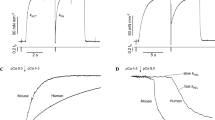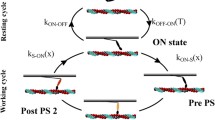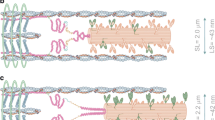Abstract
Diastolic cardiac sarcomere stiffness, sarcomere length changes, and calcium concentration [Ca2+]i were investigated in 18 trabeculae, dissected from the right ventricle of rat heart. [Ca2+]i declined following a mono-exponential diastolic time course with a time constant of 210–350 ms. During diastole, ([Ca2+]o = 1 mM), sarcomere length (SL) increases (amplitude: 5–65 nm; time constant: 600 ms). Eighty percent of muscles showed discrete spontaneous motion of sarcomeres near the end of diastole; this phenomenon occurred earlier at higher [Ca2+]o. The stiffness modulus of the sarcomere (MOD) increased by 30% during diastole (n=158; p<0.05), while the phase difference, Φ, between force and SL decreased by 13% (n=158; p<0.05). The increase of MOD and the decrease of Φ reversed when spontaneous activation occurred. These results show that the mechanical diastolic properties of the cardiac sarcomere are time dependent. The time dependence of the diastolic properties can be faithfully reproduced by a simple linear four element viscoelastic model. The diastolic changes of MOD and of Φ could be reproduced by assuming an exponential change of the elastic and viscous coefficients of the model over time with a time constant similar to the time constant of change of [Ca2+]i. We suggest that the simplest combination of structural counterparts of the model in the sarcomere consists of titin bound to both actin and myosin in the myofibril, while the sarcomere is in parallel with another purely elastic element. We propose that the Ca2+-dependence of diastolic stiffness might be the result of an inverse relation between [Ca2+]i and the affinity of titin for actin.
Access this chapter
Tax calculation will be finalised at checkout
Purchases are for personal use only
Preview
Unable to display preview. Download preview PDF.
Similar content being viewed by others
References
De Tombe PP, ter Keurs HEDJ. An internal viscous element limits unloaded velocity of sarcomere shortening in rat myocardium. J Physiol 1992;454:619–642.
Backx PH, ter Keurs HEDJ. Fluorescent properties of rat cardiac trabeculae microinjected with fura-2 salt. Am J Physiol 1993;264:H1098–H1110.
Wang K, McClure J, Tu A. Titin: Major myofibrillar components of striated muscle. Proc Nat Acad Sci USA 1979;76:3698–3702.
Brady AJ. Length dependence of passive stiffness in single cardiac myocytes. Am J Physiol 1991;260:hl062–h1071.
Granzier HLM, Irving TC. Passive tension in cardiac muscle: contribution of collagen, titin, microtubules, and intermediate filaments. Biophysical J 1995;68:1027–1044. (Abstract)
ter Keurs HEDJ, Rijnsburger WH, van Heuningen R, Nagelsmit MJ. Tension development and sarcomere length in rat cardiac trabeculae. Evidence of length-dependent activation. Circ Res 1980;46:703–714.
Daniels MCG, Noble MIM, ter Keurs HEDJ, Wohlfart B. Velocity of sarcomere shortening in rat cardiac muscle: relationship to force, sarcomere length, calcium, and time. J Physiol 1984;355:367–381.
van Heuningen R, Rijnsburger WH, ter Keurs HEDJ. Sarcomere length control in striated muscle. Am J Physiol 1982;242:H411–H420.
Goldman YE. Measurement of sarcomere shortening in skinned fibers from frog muscle by white light diffraction. Biophysical J 1987;52:57–68.
Chiesi M, Ho MM, Inesi G, Somlyo AV, Somlyo AP. Primary role of sarcoplasmic reticulum in phasic contractile activation of cardiac myocytes with shunted myolemma. J Cell Biol 1981;91:728–742.
Fabiato A, FAbiato F. Contractions induced by a calcium-triggered release of calcium from the sarcoplasmic reticulum of single skinned cardiac cells. J Physiol 1975;249:469–495.
Fabiato A. Myoplasmic free calcium concentration reached during the twitch of an intact isolated cardiac cell and during calcium-induced release of calcium from the sarcoplasmic reticulum of a skinned cardiac cell from the adult rat or rabbit ventricle. J Gen Physiol 1981;78:457–497.
Schoenberg M, Brenner B, Chalovich JM, Greene LE, Eisenberg, E. Cross-bridge attachment in relaxed muscle. Advances in Exp & Med & Biol 1984;170:269–284.
Backx PH, ter Keurs HEDJ. Restoring forces in rat cardiac trabeculae. Circulation 1988;78:II–68.
Ford LE, Huxley AF, Simmons RM. Tension response to sudden length change in stimulated frog muscle fibers near slack length. J Physiol 1977;269:441–515.
Jin JP. Cloned rat cardiac titin class I and class II motifs. Expression, purification, characterization, and interaction with F-Actin. J Biological Chem 1995;270:1–9.
Labeit S, Kolmerer B. Titins: giant proteins in charge of muscle ultrastructure and elasticity. Science 1995;270:293–296.
Erickson HP. Reversible unfolding of fibronectin type III and immunoglobulin domains provides the structural basis for stretch and elasticity of titin and fibronectin. Proc Nat Acad Sci USA 1994;91:10114–10118.
Price MG. Molecular analysis of intermediate filament cytoskeleton — a putative load bearing structure. Am J Physiol 1984;246:H566–H572.
Author information
Authors and Affiliations
Editor information
Editors and Affiliations
Rights and permissions
Copyright information
© 1997 Springer Science+Business Media New York
About this chapter
Cite this chapter
Stuyvers, B.D.M.Y., Miura, M., ter Keurs, H.E.D.J. (1997). Diastolic Viscoelastic Properties of Rat Cardiac Muscle; Involvement of Ca2+ . In: Sideman, S., Beyar, R. (eds) Analytical and Quantitative Cardiology. Advances in Experimental Medicine and Biology, vol 430. Springer, Boston, MA. https://doi.org/10.1007/978-1-4615-5959-7_2
Download citation
DOI: https://doi.org/10.1007/978-1-4615-5959-7_2
Publisher Name: Springer, Boston, MA
Print ISBN: 978-1-4613-7731-3
Online ISBN: 978-1-4615-5959-7
eBook Packages: Springer Book Archive




